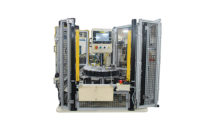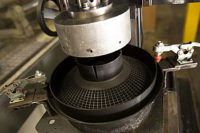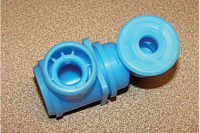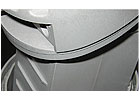
From 1996 to 1999, Sloan Flushmate used vibration welding to join the top and bottom halves of the pressure vessel of its namesake product, a pressure-assist device that empties when a toilet is flushed and then refills. The two components are injection-molded and made of polypropylene reinforced with 30 percent long glass fibers.
Although an occasional customer complained about the pressure vessel leaking during this time, in 1999, a larger number of customers complained. This led the company to recall the Flushmate and determine why the welds leaked.
Three factors were blamed:
*a resin-depleted area at the joint interface;
*interrupted energy input at certain bond line sections; and
*variation in flatness of the contact surfaces of the molded parts.
Shortly after performing this analysis, the company looked into other welding technologies to assemble the pressure vessel.
“We tested and evaluated the hot plate method, but it proved unreliable,” says Joe Bosman, chief operating officer of Sloan Flushmate. “Then we researched electromagnetic welding and had a supplier come and discuss our problems. We liked what we heard, but were told there would be a transition period before our manufacturing facility could exclusively use electromagnetic welding.”
Bosman says the transition period lasted two years and was very expensive because all their major tooling and product molds had to be redesigned to be compatible with the three electromagnetic welding systems they purchased. However, the components’ material composition did not have to change.
During the transition, Sloan Flushmate continued to use vibration welding. Since 2001, when the company began using electromagnetic welding exclusively, pressure vessels that leak at the weld line have become a very rare occurrence.
Sloan Flushmate has been so impressed with the technology that it is also used to weld a pressure regulator to the Flushmate vessel. In addition, the company has installed three more systems at its manufacturing facility and three systems at its supplier facility where welding of a regulator subassembly is done. Between its two locations, Sloan Flushmate produces 25,000 units per week, with room for another 25 percent capacity.
“For any new products we develop that require one-way assembly and don’t have to be serviced, we definitely try to incorporate electromagnetic welding,” says Bosman.

Made of glass-reinforced polypropylene, the top and bottom halves of the Sloan Flushmate pressure vessel are electromagnetically welded together. Photo courtesy Sloan Flushmate
Gaining Favor
Several manufacturers consider electromagnetic, or induction, welding a better way to weld highly filled thermoplastics than thermal or friction welding, or using adhesives. Thermal welding methods, such as hot plate, apply heat directly to the thermoplastic component with a platen or gas. However, these methods require a trap to hide the weld line flash and often require postweld trimming or cleaning.Friction methods, which include vibration, ultrasonic and spin, generate heat by physically rubbing two tightly held parts together. Unfortunately, they expose the product to a violent contact process that can generate particulate or contamination. This is especially negative for delicate parts, products with internal components, or applications that require precise part alignment.
As for adhesives, they tend to not provide a strong-enough bond between low-surface energy thermoplastics, such as olefins. As a result, pretreatment at the plastic interface is often necessary.
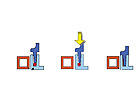
This diagram illustrates the three steps of the electromagnetic welding process. Before bonding, the bonding material is deposited in the joint. During bonding, the coil is activated and the material melts and flows under pressure into voids and irregular surfaces within the joint cavity. After bonding, the material has fused thermoplastic part surfaces at the joint interface. Graphic courtesy Emabond Solutions
The Basics
Electromagnetic welding uses inductive energy to heat a special magnetically active material that fuses together two thermoplastic parts, creating polymer-to-polymer linkages. It can be used to join large or small components in manual, semiautomatic and fully automatic assembly lines.With electromagnetic welding, fusion temperatures are quickly and efficiently established within the joint without putting excessive stress on the assembled parts. In practice, the time required for fusion ranges from less than 1 second for small assemblies, to 10 to 60 seconds for large assemblies (bond lines of 2 to 20-plus feet).
The process requires four components: an induction generator, a work coil, a fixture and a bonding material. The induction generator converts input electricity at a frequency of 50 to 60 hertz to a constant output frequency of 13.56 megahertz.
The work coil, or inductor, is a water-cooled copper coil that generates the magnetic field required to activate the bond material.
The fixture consists of two nests to hold and position the parts near the work coils. One nest is movable and the other is fixed. The nests are usually made from nonconductive materials and are incorporated into a clamping device attached to a pneumatic press. Metal components near the work coils must be shielded so they do not reduce the magnetic flux at the joint.
“The bonding material is specially formulated for each application and generally takes on the characteristics of the base polymer,” says Steve Chookazian, general manager and managing partner of Emabond Solutions. “The material consists of micron-sized ferromagnetic particles, also called susceptors, suspended within a thermoplastic matrix.”
Particles can be iron, stainless steel, ceramic or other magnetic materials. Their type, amount and size affect heating performance and efficiency, the materials being joined, and, in certain cases, compatibility with applications that must comply with NSF Intl. or Food and Drug Administration standards.
Before bonding, the electromagnetic material is deposited in the joint. The mating parts are brought together and placed inside the fixture.
During bonding, the coil is activated, briefly exposing the particles to the high-frequency 13.56 megahertz magnetic field. The particles oscillate many times per second and rapidly develop the heat required to reach fusion temperature.
Within seconds, the material melts and flows under pressure into voids and irregular surfaces within the joint cavity. The heat of the material is conducted to the abutting part surfaces, causing them to fuse at the joint interface.
A good joint design is essential to the ultimate success of the weld. Joint designs include flat to flat, flat to groove, tongue and groove, shear, and step.
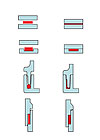
A good joint design is essential to the ultimate success of the weld. Joint designs include (top to bottom) flat to flat, flat to groove, tongue and groove, shear and step. Graphic courtesy Emabond Solutions
Expanded Capabilities
In recent years, suppliers have improved both their equipment and bonding materials. Emabond welding machines now feature solid-state radio frequency (RF) generators with a flexible power-delivery system.The generators operate at a consistent frequency of 13.56 megahertz to produce a more energy-efficient welding process than older welding machines, which featured tube-type generators that operated at variable frequencies from 2 megahertz to 8 megahertz.
Based on RF conversion technology, the power-delivery system enhances customer product design capability, welding process control and feedback. The system features a power supply, controller and matching network. Depending on welding machine used, the power supply has a power output from 300 watts to 5 kilowatts.
The controller provides self diagnostics and precisely controls energy at the bond line-including ramped power stages or power pulsing-to greatly expand manufacturers’ welding capabilities. Users can perform precise spot welding, uniform welding of irregular geometries, sequential welding of multiple joint geometries and simultaneous welding of multiple weld lines.
In addition, the system allows welding of higher-temperature thermoplastics (500 F or above), thermoplastics with internal metal components, and thermoplastics with nonplastic components, such as metal and delicate electronics, that are close to or captured within the weld line.
“The system’s moving matching network makes electromagnetic welding a dynamic process,” says Chookazian. “It allows the power source to travel with the welded part or have the part pass by a fixed RF power source. Users can easily perform continuous welding of sheets and films and create flat-to-flat weld lines of more than 20 feet.”
The system also gives manufacturers the option of acquiring welding data by connecting the welding station to a standalone PC or a network server. Manufacturers can capture data-including weld cycle heat and cool time, forward and reflected power and weld displacement-and save it in Excel files. The data acquisition package includes software, an external Ethernet port and Ethernet card.
Emabond also has developed high-performance bonding material that can be provided in various forms to meet individual application requirements. Traditional forms include: stamped gaskets, strands, extruded profiles, tapes and strips. These new materials are formulated with susceptor particle matrixes that improve heating efficiency and melt characteristics so they can be used with a wider range of thermoplastics with as little as 100 watts of power. Chookazian says the formulations are proprietary, but are in the process of commercialization.
Hellerbond recently introduced proprietary high-performance bonding materials that can reduce weld times by 50 percent to 75 percent compared to the company’s standard formula bonding materials.
“For example, if a weld takes 20 or so seconds with a standard bonding material, it could take 4 to 10 seconds with a high-performance one,” says Robert Johnson, vice president of Hellerbond.”
Johnson says these materials produce stronger welds and weld high-temperature and or high-filled engineering resins more easily. They can be custom formulated to create translucent welds that are barely visible to the naked eye, or colored welds so they exactly match the thermoplastic parts.
In addition, high-performance materials allow for welds that, previously, were impractical or impossible. One example is a weld of 30 feet or longer done in a single shot, without scanning.
“High-performance materials are not frequency limited, so they can work on a longer coil with less power than standard materials. As a result, they continue to heat and bond the thermoplastic parts even when the frequency drops as a result of the coil being very long.”

This cross-section shows where the middle screen and top and bottom halves of the WaterMax pressure vessel are joined together with a single weld. Photo courtesy Hague Quality Water
Leak-Proof Products
The vast majority of manufacturers that use electromagnetic welding do so to leak-proof vessels, tanks or other containers. Hague Quality Water International uses the process to weld the pressure vessel of its WaterMax water softener tank and the Hydro-Clean III control valve for domestic and light-commercial water softeners.When welding the pressure vessel, Hague joins three components (top and bottom halves, and middle screen) with a single weld that lasts about 60 seconds.
“The vessel used to be assembled with vibration welding, but it caused flash on the outside that had to be cut off,” says Rodger Rhinehart, chief engineer for Hague Quality Water. “The electromagnetic weld eliminates the flash, as well as the need to install the center screen with six screws and a seal.”
A single weld is also performed in the assembly of the Hydro-Clean III control valve, which can be screwed onto the tank of any standard water softener. The weld lasts about 4 seconds and joins two internal components.
Another manufacturer that has benefitted from electromagnetic welding is Zodiac Pool Systems Inc., which welds the vessels of its AquaPure chlorinator and Nature2 sanitizer. Made of ABS, the AquaPure vessel consists of top and bottom halves that are welded in 10 seconds.
Nature2 vessels, which are made of polypropylene, have been electromagnetically welded for about 1-½ years. Welding lasts 30 seconds.
“Adhesives were used to assemble the AquaPure vessel up until about 4 years ago,” says Curt Spivey, manufacturing engineer for Zodiac Pool Systems. “But it was messy and resulted in inconsistent quality. We needed a water-tight system, and electromagnetic welding has a great record of creating water-tight products.”

